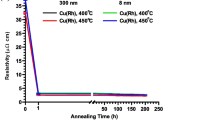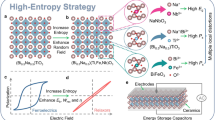Abstract
The preparation of ZnO varistors include 96.505 mol% ZnO, 1.05 mol% Bi2O3, 1 mol% Co2O3, 1 mol% Sb2O3, 0.045 mol% CaO. In this paper, the aging characteristics of ZnO varistor when accelerated alternating current (AC) aging charge is 0.9 E1mA (135 °C/160 h) are investigated. The ZnO varistor not only has a good breakdown voltage and low leakage current, but also the electric field current characteristics before and after aging according to the ZnO varistor E-J and C-V. After aging, the breakdown voltage and leakage current change rate are small. The results show that the Ca-doped ZnO varistors can slow down the aging rate to a certain extent and have good stability under the AC electric field. It provides a basis for the preparation of highly stable ZnO varistors.




Similar content being viewed by others
References
S. Boggs, J. Kuang, I. Andoh, S. Nishiwaki, Increased energy absorption in ZnO arrester elements through control of electrode edge margin. IEEE Trans. Power Deliv. 15, 562–568 (2000)
T.K. Gupta, Application of zinc oxide varistors. J. Am. Ceram. Soc. 73, 1817–1840 (1990)
E. Leite, J. Varela, E. Longo, A new interpretation for the degradation phenomenon of ZnO varistors. J. Mater. Sci. 27, 5325–5329 (1992)
Analysis of thermal runaway phenomenon caused by ZnO varistor operation using finite element method. J. Korean Inst. Electr. Electron. Mater. Eng. 35, 372–376 (2022)
J.J. Bang, C.S. Huh, Response characteristic analysis of ZnO varistors by the conductive E1 pulse. J. Korean Inst. Electr. Electron. Mater. Eng. 32, 241–245 (2019)
H. Wang, H. Zhao, An economical dopant for improving the comprehensive electrical properties of ZnO varistor ceramics. Mater. Lett. 279, 128471 (2020)
S. Han, H. Cho, J. He, The statistic analysis on principal electric parameters of MOV for surge arrester, in IEEE/PES Transmission and Distribution Conference and Exhibition, vol. 3 (2002), pp. 2208–2211
J Montenegro, J Ramirez, Degradation of zinc oxide varistors, in Proceedings of First International Caracas Conference on Devices, vol. 5 (1981), pp. 352–354
T. Tada, Degradation of ZnO varistors as estimated by aging tests. Electr. Eng. Japan 170, 1–18 (2010)
N. Raghu, T. Kutty, Relationship between nonline arresistivity and the varistor forming mechanism in ZnO ceramics. Appl. Phys. Lett. 60, 100–102 (1992)
M. Wang, C. Yao, Degradation characteristics of low-voltage ZnO varistor manufactured by chemical coprecipitation processing. J. Mater. Process. Technol. 202, 406–411 (2008)
P. Meng, S. Gu, Improving electrical properties of multiple dopant ZnO varistor by doping with indium and gallium. Ceram. Int. 44, 1168–1171 (2017)
J. He, C. Cheng, J. Hu, An analytic approach to the degradation of double-Schottky barrier: theoretical prediction of VO0–Zni2+:Zni2+ as dominant mobile ion in ZnO electroceramic. Scr. Mater. 104, 25–28 (2015)
T. Gupta, W. Carlson, A grain-boundary defect model for instability/stability of a ZnO varistor. J. Mater. Sci. 20, 3487–3500 (1985)
Acknowledgements
This work was supported by the Natural Science Foundation of Xinjiang (2022D01C21).
Author information
Authors and Affiliations
Corresponding author
Ethics declarations
Conflict of interest
The author has no interest in the editors, reviewers and readers of the journal.
The authors declare that they have no known competing financial interests or personal relationships that could have appeared to influence the work reported in this paper.
Additional information
Publisher's Note
Springer Nature remains neutral with regard to jurisdictional claims in published maps and institutional affiliations.
Rights and permissions
Springer Nature or its licensor (e.g. a society or other partner) holds exclusive rights to this article under a publishing agreement with the author(s) or other rightsholder(s); author self-archiving of the accepted manuscript version of this article is solely governed by the terms of such publishing agreement and applicable law.
About this article
Cite this article
Sun, G., Zhao, H. Improving Stability and Low Leakage Current of ZnO Varistors Ceramics. Trans. Electr. Electron. Mater. 24, 267–270 (2023). https://doi.org/10.1007/s42341-023-00447-7
Received:
Revised:
Accepted:
Published:
Issue Date:
DOI: https://doi.org/10.1007/s42341-023-00447-7




